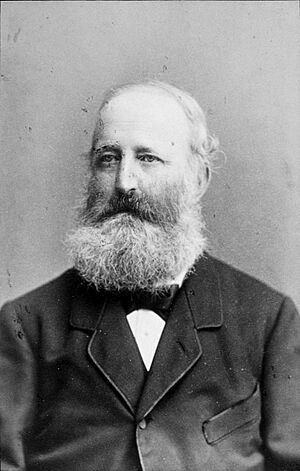Franz Ritter von Hauer facts for kids
Franz von Hauer (born January 30, 1822 – died March 20, 1899) was a very important Austrian geologist. Geologists are scientists who study the Earth's rocks, minerals, and history. Franz von Hauer made many discoveries about ancient life and helped create detailed maps of the Earth.
Contents
Early Life and Education
Franz von Hauer was born in Vienna, which is the capital city of Austria. His father, Joseph von Hauer, was also a well-known scientist. Joseph von Hauer studied palaeontology, which is the study of fossils and ancient life.
Franz followed in his father's footsteps. He studied geology at a special mining school called Schemnitz from 1839 to 1843. After finishing his studies, he worked for a while in mining in a region called Styria.
A Career in Geology
In 1846, Franz von Hauer started working at the mineral museum in Vienna. He was an assistant to another famous scientist, Wilhelm von Haidinger. Just three years later, he joined the Imperial Geological Institute. This was a very important place for studying the Earth.
Franz von Hauer became the director of the Imperial Geological Institute in 1866. This meant he was in charge of all the important geological research happening there. Later, in 1886, he became the head of the Imperial Natural History Museum in Vienna.
Major Discoveries and Contributions
Franz von Hauer made many important contributions to geology. One of his special areas of study was Cephalopods. These are a group of sea animals that include modern-day squids and octopuses. He studied the fossils of these creatures from the Triassic and Jurassic periods. He discovered and named 89 different species of ancient cephalopods. His work helped scientists understand more about these ancient sea animals.
Perhaps his most famous work was creating the Geological Map of Austro-Hungary. This huge map showed all the different types of rocks and landforms in the Austro-Hungarian Empire. It was made up of twelve large sheets and was first published between 1867 and 1871. He updated it several times, and the fourth edition in 1884 even included areas like Bosnia and Montenegro. This map was a huge help for other geologists and for understanding the land.
Awards and Recognition
Franz von Hauer's hard work and discoveries were recognized around the world. In 1874, he was chosen to be a member of the American Philosophical Society. This is a very old and respected group of thinkers and scientists in the United States.
In 1882, he received the Wollaston medal from the Geological Society of London. This is one of the highest awards a geologist can receive. He was also made a foreign correspondent of the Geological Society of London. This meant he was an important international contact for the society.
In 1892, Franz von Hauer became a life-member of the upper house of the Austrian parliament. This was a great honor, showing how respected he was in his country.
Legacy
Franz von Hauer's work left a lasting impact on geology. A special mineral called Hauerite is named after him and his father. This shows how important their contributions were to the study of minerals and the Earth.


